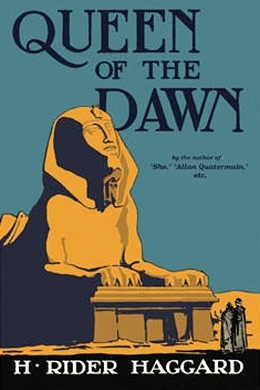
-
EPUB 351 KB
-
Kindle 438 KB
-
Support epubBooks by making a small $2.99 PayPal donation purchase.
This work is available for countries where copyright is Life+70 or less.
Description
The last book published in Haggard’s lifetime is a standalone ancient-Egyptian fantasy. It opens at an almost breakneck pace, with Pharaoh deposed and killed, his wife and child in hiding, and the goddesses stirring. A secret religious order raises the Pharaoh’s daughter, and she meets and falls in love with the usurper’s disguised son. The climax features traditional adventure-fiction excitement (battle and torture).
425 pages with a reading time of ~6.50 hours (106422 words), and first published in 1925. This DRM-Free edition published by epubBooks, 2016.
Community Reviews
There are currently no other reviews for this book.
Excerpt
There was war in Egypt and Egypt was rent in two. At Memphis in the north, at Tanis, and in all the rich lands of the Delta where by many mouths the Nile flows down to the sea, a usurping race held power, that whose forefathers, generations before, had descended upon Egypt like a flood, destroyed its temples and deposed its gods, possessing themselves of the wealth of the land. At Thebes in the south the descendants of the ancient Pharaohs still ruled precariously, again and again attempting to drive out the fierce Semitic or Bedouin kings, named the Shepherds, whose banners flew from the walls of all the northern cities. They failed because they were too weak, indeed the hour of their final victory was yet far away and of it our tale does not tell. Nefra the Princess, she who was named the Beautiful and afterwards was known as Uniter of Lands, was the only child of one of these Theban Antefs, Kheperra, born of his Queen, Rima, daughter of Ditanah, the King of Babylon, who had given her to him in marriage to strengthen him in his struggle against the Shepherds, also called the /Aati/ or “Plague-bearers.” Nefra was the first and only child of this marriage, for shortly after she was born Kheperra the King, her father, with all the host that he could gather, went down Nile to fight the Aati who marched to meet him from Tanis and from Memphis. They met in a great battle in which Kheperra was slain and his army defeated, though not before it had slaughtered such numbers of the enemy that, abandoning their advance on Thebes, the generals of the Shepherds returned with the remnant of their troops whence they came. Yet by this victory Apepi, the King of the Shepherds, became in fact Pharaoh of all Egypt. Kheperra was dead, leaving behind him but one infant girl, and so were numbers of the great Theban lords, others of whom hastened to submit to the ruler of the North. The Shepherd people too, like the Egyptians of the South, were weary of war and would not fight again. Therefore, although they were defeated, no cruelties were inflicted upon the followers of Kheperra, nor was great tribute asked of them; also they were allowed to worship their ancient gods in peace, and this in the northern as well as the southern lands. Indeed, by now, although the god of the Shepherds was Baal, to whom they gave the name of Set because already it was well known upon the Nile, the Shepherd kings re-built the temples of Ra and Amen and Ptah, of Isis and of Hathor, that their forefathers had destroyed when first they invaded Egypt, and themselves made offerings in them, acknowledging these divinities. Only one thing did Apepi demand of the conquered Thebans, namely that Rima the Queen of dead Kheperra, and the babe Nefra, his daughter and lawful heiress of Upper Egypt, should be given up to him, hearing which Rima hid herself away with the child, as shall be told. Now of the birth of Nefra the Princess there were strange stories. It was said that after she came into the world, a very fair babe, gray- eyed, light-skinned, and black-haired, and the rites had been accomplished, she was laid upon her mother’s bosom. When Rima had looked upon her and she had been shown to the King her father, in a weak voice, for she had suffered much, the Queen demanded to be left alone, so earnestly that the physicians and women thought it best to appear to obey her and withdrew themselves behind certain curtains that divided the birth-chamber from another, where they remained silent. The night had fallen and the birth-chamber was dark, for as yet Rima could bear no light near her. Yet of a sudden one of the women, a priestess of Hathor named Kemmah, who had nursed the King Kheperra from his birth and now was to fill that office to his child, having remained awake, saw a light glowing through the curtains, and being frightened, peeped between them. Behold! in the birth-chamber, looking down on the Queen, who seemed to be asleep, were two royal and glorious women or so Kemmah swore and believed, from whose robes and bodies flowed light and whose eyes shone like stars. Queens they seemed to be, no less, for there were crowns upon their heads and they glittered with jewels which only queens could wear. Moreover, one of them held in her hand the Cross of Life fashioned in gold, and the other a looped sistrum with gems strung on golden wires, such as is used to make music when the priestesses walk in procession before the statues of the gods.
